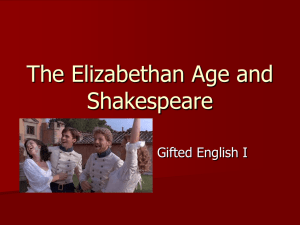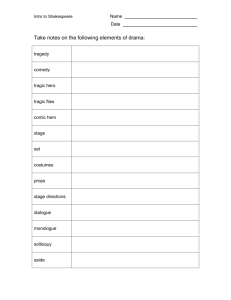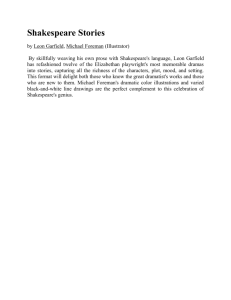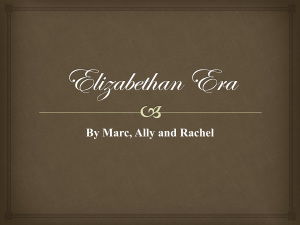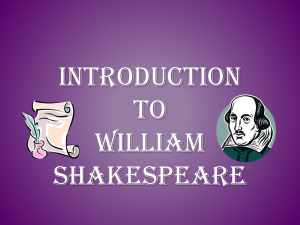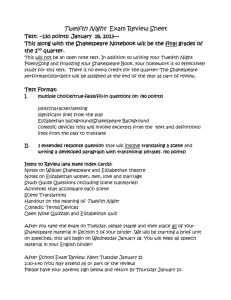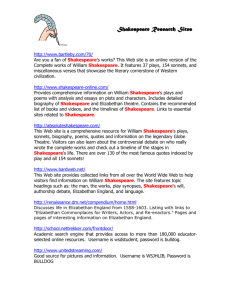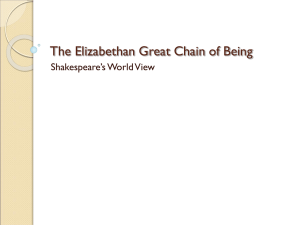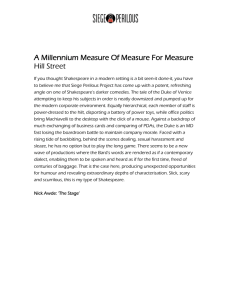Shakespeare and His Theatre
advertisement
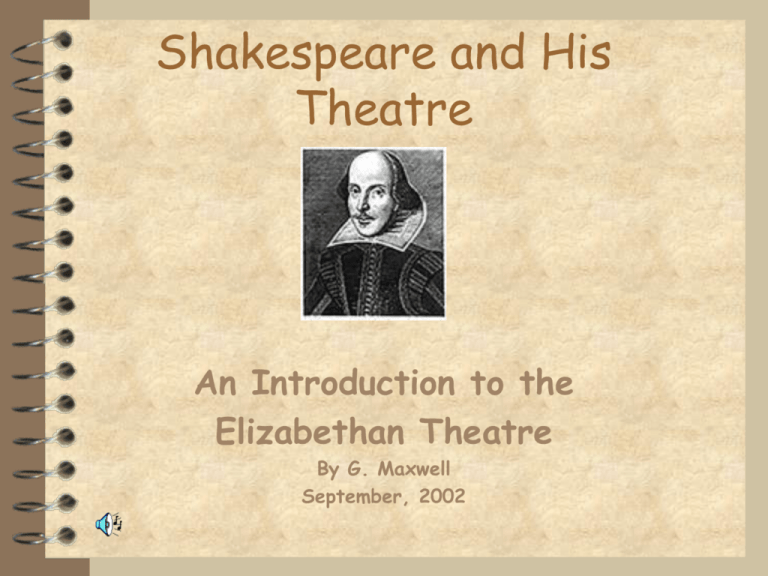
Shakespeare and His Theatre An Introduction to the Elizabethan Theatre By G. Maxwell September, 2002 The Tudor Family Henry VII’s plan for succession Oldest son, Arthur, marries Catherine of Aragon (princess of Spain) in 1501 Daughter Margaret marries King James IV of Scotland Daughter Mary marries King Louis XII of France After Arthur’s death in 1502, second son Henry marries Catherine of Aragon in 1509 Henry VIII (1509-1547) King Henry VIII was a poet, musician, sportsman, and scholar He strongly supported the arts King Henry VIII was a powerful and influential man; he was determined to continue the Tudor line with a male heir The Six Wives of Henry VIII Henry married Catherine of Aragon They had 5 children, only Mary survived In 1527 Henry divorced Catherine and in doing so created the Church of England Anne Boleyn Henry secretly married Anne Boleyn while still married to Catherine Anne gave birth to Elizabeth (this birth angered Henry) Anne miscarried a male fetus in January of 1536 On order of Henry VIII, Anne was beheaded in May of 1536 Jane Seymour Henry married Jane the same month Anne was beheaded Jane gave birth to Edward VI of England through caesarian section Jane died 12 days after the birth Henry marries 3 more times, but has no more children. He dies 9 years later in 1547. Edward VI: the child king (1547 – 1553) Edward VI was crowned at the age of nine (upon Henry’s death) Edward was betrothed to his cousin, Mary Queen of Scots He died of tuberculosis at the age of 16 Fight for the Throne Edward’s death caused a great upheaval at court Edward was succeeded by Lady Jane Grey (at age 15) who was merely a pawn and reigned for nine days before she was arrested for treason The throne was now taken by Mary Tudor (Catherine of Aragon’s daughter) Fight for the Throne Continued Mary Tudor (or Bloody Mary) ascended the throne in 1553 Mary I denounced the Church of England and persecuted Protestants Mary died in 1558 and Elizabeth (Ann Boleyn’s daughter) became Queen Queen Elizabeth I (1558-1603) After the unhappiness of Mary’s rule, Elizabeth came to the throne with much rejoicing Elizabeth reinstated the Church of England Elizabeth was very welleducated – spoke 6 languages Elizabeth was fond of the arts (as was her father) and she sponsored artists, poets, musicians and playwrights Elizabeth did not marry, nor did she have children -- “The Virgin Queen” Turning the tide on the Spanish Armada To show her faith in the English forces, she personally rode on horseback to the port to inspire them: “I have placed my chiefest strength and safeguard in the loyal hearts and good-will of my subjects; and therefore I am come amongst you, as you see, at this time, not for my recreation and disport, but being resolved, in the midst and heat of the battle, to live and die amongst you all; to lay down for my God, and for my kingdom, and my people, my honour and my blood, even in the dust. I know I have the body but of a weak and feeble woman; but I have the heart and stomach of a king, and of a king of England too.” Elizabethan Society -Renaissance During Elizabeth’s reign, an incredible movement was taking over Europe -The Renaissance Art, music, theatre, dance, and architecture were being revolutionized The invention of the printing press (1440) dramatically increased literacy Elizabethan Society -Ideals Elizabethan society held members of the noble class in high regard; family honour was of great importance Elizabeth also encouraged her Ladies and Lords to follow the rules of courtly love The concept of idealized, unattainable love greatly affected the artists at the time The Great Chain of Being Elizabethans believed that all things had a place in the hierarchy of being It was believed that you could not change your stars, but must fulfill your role as given to you by God Kings and Queens have “divine right” (the power and approval of God) The Great Chain of Being: on earth Magical and Supernatural Forces The Elizabethans believed in the power of the supernatural or magical – a realm above mortals but below heaven Witches, fairies, fate, destiny, the power of the stars and the moon, are all featured quite heavily in Elizabethan art Without scientific explanation, unusual illnesses or events were explained using the supernatural or magical Elizabethan Society – the role of the Fool a fool or jester was a common sight at Court during Henry VIII’s reign and Elizabeth I’s reign these fools were “artificial” fools -- they acted to entertain or sometimes gave advice Elizabethan Society -Fashion Elizabethan dress was gorgeous and elaborate, mirroring the prosperity and energy of the age -- nobles donated their clothing to acting companies which they sponsored Elizabethan Society -Fashion Men and women often curled or dyed their hair. On occasion they used false hair or full wigs Men's hair was worn in a variety of styles, cut short at the sides, brushed up and held with gum or wax, or curled all over Beards were sometimes dyed to coordinate with an outfit or the wearer's mood. A carnation beard "speckled with green and russett" would mark the return of a loved one, for example. Elizabethan Society -- Food Elizabethans ate a diet of meat, grains and root vegetables (potatoes, carrots, beetroot, etc.) Elizabethans did not drink water as it was often polluted, and instead drank ale and wine Elizabethan Society -- Marriage Marriage was a religious, economic, and practical necessity. In the nobility, it was a major means of increasing capital The husband ruled the family based on religious conceptions of hierarchy Elizabethan Society -- Weddings Weddings were cause for great celebration in all levels of society Celebrations would be spread over several days, and included singing, dancing, feasting, contests, and at times, performances by actors, jugglers, fools etc. Elizabethan Society -Huswifery John Fitzherbert (A Book of Husbandry, 1525) offers this advice: and evening and give thy pullen [fowl] meat in the morning, and when time of When thou art up and ready, then the year cometh, thou must take heed first sweep thy house, dress up thy how thy hen, ducks and geese do lay, dish-board, and set all things in good order within thy house; milk thy kine and to gather up their eggs; and when they wax broody to set them thereas no [cows], feed thy calves, sile [strain] up thy milk, take up thy children and beasts, swine or other vermin hurt array them, and provide for thy them. husband's breakfast, dinner, supper, and for thy children and servants, and take thy part with them. And to ordain [organize] corn and malt to the mill, to bake and brew withal when need is. . . Thou must make butter and cheese when thou may; serve thy swine, both morning Elizabethan Society -Huswifery A housewife must also: care for her family in sickness and health, provide (deliver) children, prepare all food, drink, make all clothes, look after all animals, grow food, and care for the family’s finances Elizabethan Society -Husbandman The husband was in charge of all major work outside the home He ploughed, sowed, made hay, harvested, threshed, slaughtered the large animals, and kept up the maintenance of the house Sports for men included: hunting, hawking, fishing, archery, and cockfighting Cockfighting… Cockfighting… Elizabethan Society -- London Many people lived in London, England’s busiest and most vibrant city London was the port where ships would arrive The city was crowded and full of noise and disease Public buildings were often closed down due to the plague Plague!!! Plague!!! Elizabethan Society – Trade Guilds A guild is a group of craftspeople who have joined together for mutual protection, and establishment of professional standards The levels include: Master, Journeyman, and Apprentice Guilds also performed as actors, putting on elaborate performances to promote their professionalism Examples of professions with guilds: Bakers, Joiners, Tinkers, Watchmen, Actors, Bankers, Blacksmiths, Saddlers, etc. Elizabethan Society -Entertainment Elizabeth appointed a Master of the Revels -- a censorship body which had absolute control over all entertainment Elizabeth held great tournaments (which included wrestling, jousting (or tilting), and other combat contests London -- Location of Entertainment The City of London is divided by the River Thames – population today is over 7 million In the Elizabethan era – population 250,000 The south bank of the Thames was outside the City limits Theatre, Baiting and Prostitution became illegal inside the city limits Therefore, all entertainment buildings and bawdy houses were located on the South side of the river Entertainment must be reached by boat (or over very crowded bridges) All affluent society lived in London proper (the north bank of the Thames) London -- Location of Entertainment Elizabethan Society -- Entertainment Bear-baiting and bull-baiting were common public sports in London Hangings were also a public form of entertainment Often, such events were closed down due to the plague (a disease spread from rats via fleas– but this was unknown at the time) Elizabethan Society -Theatre Another form of popular entertainment was the theatre - a “hit” production might be seen by 50% of the male population People from all social classes visited the theatre (including royalty) By 1600, half of the 3.5 million people in England had some education Plays were comedies, dramas or romances Plays were mostly performed during the day There were several important playwrights of the time including Marlowe, Lyly, Kidd, Jonson, and Shakespeare Elizabethan Society -Theatre Plays were performed in open-air, wooden theatres First public playhouse opened in 1576 The theatres were round (or oval) and had tiers of seating for the public Notable theatres of the time: The Rose, The Theatre, The Swan, and The Globe (1599) The theatres had few points of entry and no washrooms Elizabethan Society -Theatre Areas for viewing included: the pit, the Gentleman’s Rooms, the covered galleries and the Lords’ Rooms Each area charged a different amount: the Lords' Room:1 shilling , the Gentlemen's Rooms: 6 pence, the galleries: 2 pence, the pit (for the "groundlings"): 1 penny Elizabethan Society -Theatre Playbills were handed out as publicity, but since much of the populace was illiterate, a flag was raised at the theatres on performance days Plays were performed in Repertoire -- on a rotating schedule Elizabethan Society -Theatre The general atmosphere in an outdoor theatre was loud and raucous Prostitutes, pick-pockets, orange sellers and buskers milled in the pit, trying to make some money The audience booed or cheered the action -- often throwing fruit if the performance was substandard Elizabethan Society -Theatre On June 29, 1613, a cannon shot during the opening of Shakespeare’s Henry VIII set the roof of The Globe Theatre on fire The original Globe theatre burned to the ground The Globe Theatre -- today The Globe Theatre has been rebuilt on the south bank of the Thames in London The company and theatre are run as they would have been in Elizabethan times with matinees, plays in repertoire, and similar production values (no lighting; minimal set design) and an all-male acting company The Globe Theatre -- today The flag still flies to tell people that a performance is scheduled for that day Some concessions have been made for modern audiences – washrooms have been put in, and there are sprinklers on the thatched roof to prevent a fire from destroying the wooden structure And another show has been added: shows run at 2:00 and 6:00 The Globe Theatre -- today Admission costs for the pit, the tiered seating, the Gentlemen’s Rooms and the Lord’s Rooms are relative to the cost during the Elizabethan era. Today, standing in the pit to see a show will cost you £5.00 ($12.00) You may not sit in the pit (you will be asked to leave if you do) The Globe Theatre -- today There is a thrust stage, with a roof (the groundlings still get wet if it rains!) The stage is about 4 ½ feet off the ground (so you have to look over people’s heads to see the action The Globe Theatre -- today You can see the balconies and the Lord’s Rooms in this photograph The central balcony would be used for musicians and any “balcony scenes” in the plays The ceiling of the stage is very ornate (as most of the groundlings only have a clear view of the ceiling) Elizabethan Society – Acting Companies Actors were in troupes or companies (8-20 men) The companies were arranged like the guilds with share- holders, apprentices, and hired men Between 1590 and 1642, there were approximately twenty companies of actors in London (although only four or five played in town at one time), and more than a hundred provincial troupes Elizabethan Society – Acting Companies All acting companies by law had to be sponsored by a nobleman and wear his colours, or “livery” The Queen sponsored a company (The Queen’s Men) All actors found without a sponsor were arrested as beggars Elizabethan Society -- Actors Actors usually played similar characters in all plays -- the lead, the king, the comic character All actors sang and danced (music is a feature of all plays -- even tragedies) Musicians played music throughout the performance from a gallery off stage Performances often started with an “opening act” of music or slapstick and ended with a dance Elizabethan Society -Actors Women were not allowed on stage -- all female parts were played by young male apprentices (until their voices changed) Male children were allowed to act and Queen Elizabeth sponsored a troupe of child actors for many years Elizabethan Society -Actors There were several popular and talented acting troupes including: Lord Admiral’s Men (lead actor: Edward Alleyn), and Lord Chamberlain’s Men -- later the King’s Men (lead actor: Richard Burbage) The Lord Chamberlain’s Men had a very talented, young, up-start playwright and actor in their company -- William Shakespeare William Shakespeare -- Child William Shakespeare was born/baptized on April 23, 1564 in Stratford-upon-Avon He was the third of eight children born to John and Mary Shakespeare William Shakespeare -School His father was a local businessman and town councillor Shakespeare was educated at the village school, and did not attend university He would have read books like the Hornbook (a religious reading), and other books in Latin and Greek He would have learned to write in italic hand with a quill and ink William Shakespeare -Family Shakespeare was granted a marriage license on November 27, 1582 to marry Anne Hathaway Anne Hathaway was eight years Shakespeare’s senior (she was 26 and he 18) William Shakespeare -Family William and Anne had three children: Susanna, Hamnet and Judith (Hamnet died at 11 years of age) William Shakespeare -London Shakespeare left his family in Stratford in 1592 (approximately) and moved to London He is first mentioned in A Groats-worth of Witte by Robert Greene as an “upstart crow” William Shakespeare -Author During his time in London, Shakespeare joined Lord Strange’s Men (later Lord Chamberlain’s men and still later the King’s Men) Shakespeare was primarily a playwright, however he also acted bit parts Shakespeare wrote plays, sonnets (154 of them!) and narrative poems William Shakespeare -Published Plays were not considered literature and were not generally published Actors were given “sides” which contained only their own parts Shakespeare’s plays were published shortly after his death due to their popularity They were published in quarto and folio The texts are unreliable since typesetters did not include punctuation and spelling was not standardized Elizabeth I -- End of an era Elizabeth I was said to have “admired” Shakespeare’s plays and helped their popularity Elizabeth I died on March 24, 1603 The crown passed to James VI of Scotland who became James I of England James I -- Patron of the Arts James I became a patron of Shakespeare’s troupe, Lord Chamberlain’s Men -renaming them the King’s Men Shakespeare enjoyed great prosperity during these years. His family received a Coat of Arms and he purchased a large house in Stratford William Shakespeare -Retirement Approximately 1610, Shakespeare returned to Stratford He wrote two plays in retirement, and regularly returned to London William Shakespeare -Death William Shakespeare died on April 23, 1616 He had written 37 plays, and numerous sonnets and narrative poems – now translated into over 50 languages He is considered the greatest English writer in history “He was not for an age, but for all time…” Works Cited Brockett, Oscar and Franklin, J. Hildy. History of the Theatre. Allyn & Bacon: Toronto, 1990. Evans, G. Blakemore, et al. The Riverside Shakespeare. Houghton Mifflin: New York, 1990. Folger Shakespeare Library 2000. http://www.folger.edu/Home_02B.html (2 Jan. 2002). Rusche, Harry. “Shakespeare Illustrated” 2001. http://www.emory.edu/ENGLISH/classes/Shakespeare_Illustrated/Shakespeare.html (2 Jan. 2002). Shakespeare.com. 2001. http://www.shakespeare.com/ (4 Jan. 2002). Shakespeare’s Globe Research Database – English Department, University of Reading. 2000. http://www.rdg.ac.uk/globe/ (4 Jan. 2002). Surfing with the Bard 2001. http://www.ulen.com/shakespeare/ (2 Jan. 2002).
